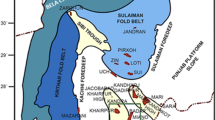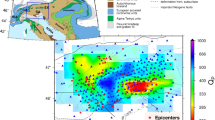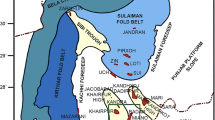Abstract
Incised marine valleys (ISVs) form brilliant petroleum systems. The development of an ISV occurs throughout a rapidly falling sea, followed by a subsequent rise (transgressive system), which fills the ISV with coarse-grained reservoir facies. These reservoir facies have variable velocities, thicknesses, and lateral continuity, which are not predictable using bandlimited seismic amplitude. This study used a new technique for imaging the heterogeneous depositional systems of the early Cretaceous Middle Indus Basin of Pakistan. This technique uses amplitude-based inverted velocity simulations (SIVS) to quantify the ISVs. The conventional amplitudes can predict the 31-m-thickest sandstone-filled ISVs with a laterally continuous distance of 9 km. The 18-Hz waveform-based SIVS predicted the 8.2 m thick reservoir facies of channelized sandstone with a laterally continuous distance of 2 km. The SIVS predicted the tuning effects due to destructive interference of the down-going seismic waves along the erosional zones of the channel system, which have simulated velocities of 3674 to 5237 m/s. The SIVS simulated the actual velocities of the seismic waves of Pakistan’s Indus natural gas systems with a deposition of 8 to 8.2 m thick sandstone-filled channels and velocities of 2960 to 2992 m/s. This work has strong implications for achieving enhanced thickness of sedimentary reservoirs inside ISVs, which can be used for exploring any shoreline petroleum system with similar geology and structure.






Similar content being viewed by others
Data Availability
The software used for this research project was the academic license-based Kingdom 8.6 version. All the data sets are available in the data repository site of Land Mark resources (LMKR) Pvt Ltd. to have access to all researchers.
References
Abd Elaziz, M., Ghoneimi, A., Elsheikh, A. H., Abualigah, L., Bakry, A., & Nabih, M. (2022). Predicting Shale volume from seismic traces using modified random vector functional link based on transient search optimization model: A case study from Netherlands North Sea. Natural Resources Research, 1–17.
Abdelwahhab, M. A., Radwan, A. A., Mahmoud, H., & Mansour, A. (2022). Geophysical 3D-static reservoir and basin modeling of a Jurassic estuarine system (JG-Oilfield, Abu Gharadig basin, Egypt). Journal of Asian Earth Sciences, 225, 105067.
Abdulaziz, A. M. (2020). The effective seismic attributes in porosity prediction for different rock types: Some implications from four case studies. Egyptian Journal of Petroleum, 29(1), 95–104.
Castagna, J. P., & Sun, S. (2006). Comparison of spectral decomposition methods. First break, 24(3).
Chopra, S., & Marfurt, K. J. (2016). Spectral decomposition and spectral balancing of seismic data. The Leading Edge, 35(2), 176–179.
Fatima, M., Kumar, L., Bhattacharjee, R. K., Rao, P. H., & Sinha, D. P. (2010). Improving resolution with spectral balancing—A Case study. In 8th Biennial international conference & exposition on petroleum geophysics, Hyderabad, India (Vol. 13). https://spgindia.org/2010/299.pdf
Ismail, A., Ewida, H. F., Nazeri, S., Al-Ibiary, M. G., & Zollo, A. (2022). Gas channels and chimneys prediction using artificial neural networks and multi-seismic attributes, offshore West Nile Delta, Egypt. Journal of Petroleum Science and Engineering, 208, 109349.
Kumar, R., Das, B., Chatterjee, R., & Sain, K. (2016). A methodology of porosity estimation from inversion of post-stack seismic data. Journal of Natural Gas Science and Engineering, 28, 356–364.
Kumar, P. C., & Sain, K. (2018). Attribute amalgamation-aiding interpretation of faults from seismic data: An example from Waitara 3D prospect in Taranaki basin off New Zealand. Journal of Applied Geophysics, 159, 52–68.
Li, S., Zhu, H., Yang, X., & Xu, C. (2021b). Seismic geomorphology, architecture and genesis of unusual confined and semiconfined sedimentary units on the northern slope of the Bonan uplift, Bohai Bay Basin, China. Journal of Petroleum Science and Engineering, 196, 107696.
Li, W., Yue, D., Colombera, L., Du, Y., Zhang, S., Liu, R., & Wang, W. (2021a). Quantitative prediction of fluvial sandbodies by combining seismic attributes of neighboring zones. Journal of Petroleum Science and Engineering, 196, 107749.
Li, W., Yue, D., Wang, W., Wang, W., Wu, S., Li, J., & Chen, D. (2019). Fusing multiple frequency-decomposed seismic attributes with machine learning for thickness prediction and sedimentary facies interpretation in fluvial reservoirs. Journal of Petroleum Science and Engineering, 177, 1087–1102.
Mitchum, R. M., Sangree, J. B., Vail, P. R., & Wornardt, W. W. (1993). Recognizing sequences and systems tracts from well logs, seismic data, and biostratigraphy: Examples from the Late Cenozoic of the Gulf of Mexico. Chapter 7: Recent applications of siliciclastic sequence stratigraphy.
Naseer, M. T. (2020). Seismic attributes and reservoir simulation application to image the shallow-marine reservoirs of Middle-Eocene carbonates, SW Pakistan. Journal of Petroleum Science and Engineering, 195, 107711.
Naseer, M. T. (2021a). Imaging of stratigraphic pinch-out traps within the lower cretaceous Shaly-Sandstone system, Pakistan, using 3D quantitative seismic inverted porosity-velocity modeling. Natural Resources Research, 30(6), 4297–4327.
Naseer, M. T. (2021b). Seismic attributes and quantitative stratigraphic simulation’application for imaging the thin-bedded incised valley stratigraphic traps of Cretaceous sedimentary fairway, Pakistan. Marine and Petroleum Geology, 134, 105336.
Naseer, M. T., & Asim, S. (2017). Detection of cretaceous incised-valley shale for resource play, Miano gas field, SW Pakistan: Spectral decomposition using continuous wavelet transform. Journal of Asian Earth Sciences, 147, 358–377.
Okoli, A. E., Agbasi, O. E., Lashin, A. A., & Sen, S. (2021). Static reservoir modeling of the eocene clastic reservoirs in the Q-field, Niger Delta, Nigeria. Natural Resources Research, 30(2), 1411–1425.
Partyka, G., Gridley, J., & Lopez, J. (1999). Interpretational applications of spectral decomposition in reservoir characterization. The Leading Edge, 18(3), 353–360.
Takougang, E. M. T., Bouzidi, Y., & Ali, M. Y. (2019). Characterization of small faults and fractures in a carbonate reservoir using waveform inversion, reverse time migration, and seismic attributes. Journal of Applied Geophysics, 161, 116–123.
Takougang Kingni, S., Rajagopal, K., Çiçek, S., Srinivasan, A., & Karthikeyan, A. (2020). Dynamic analysis, FPGA implementation, and cryptographic application of an autonomous 5D chaotic system with offset boosting. Frontiers of Information Technology & Electronic Engineering, 21, 950–961.
Taner, M. T. (2001). Seismic attributes. CSEG recorder, 26(7), 48–56.
Tayyab, M. N., & Asim, S. (2017). Application of spectral decomposition for the detection of fluvial sand reservoirs, Indus Basin, SW Pakistan. Geosciences Journal, 21, 595–605.
Urbaniec, A., Łaba-Biel, A., Kwietniak, A., & Fashagba, I. (2021). Seismostratigraphic interpretation of upper cretaceous reservoir from the Carpathian Foreland, Southern Poland. Energies, 14(22), 7776.
Acknowledgments
Dr. Muhammad Tayyab Naseer is highly thankful to DGPC and LMKR for providing the databases (2D & 3D seismic) and permission to publish this innovative work on the Lower Indus Basin. The SMT Kingdom Software 8.6 is acknowledged for providing the academic license of this geophysical and geological interpretation platform.
Author information
Authors and Affiliations
Corresponding author
Ethics declarations
Conflict of Interests
There are no conflict of interests between the authors. All the authors are agreeing for this publication.
Rights and permissions
Springer Nature or its licensor (e.g. a society or other partner) holds exclusive rights to this article under a publishing agreement with the author(s) or other rightsholder(s); author self-archiving of the accepted manuscript version of this article is solely governed by the terms of such publishing agreement and applicable law.
About this article
Cite this article
Naseer, M.T. Spectral Decomposition-Based Quantitative Inverted Velocity Dynamical Simulations of Early Cretaceous Shaly-Sandstone Natural Gas System, Indus Basin, Pakistan: Implications for Low-Velocity Anomalous Zones for Gas Exploration. Nat Resour Res 32, 1135–1146 (2023). https://doi.org/10.1007/s11053-023-10195-3
Received:
Accepted:
Published:
Issue Date:
DOI: https://doi.org/10.1007/s11053-023-10195-3




